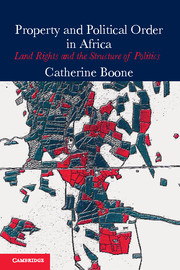Book contents
- Frontmatter
- Dedication
- Contents
- List of Figures, Tables and Maps
- Preface and Acknowledgments
- 1 Introduction
- Part I Property Rights and the Structure of Politics
- Part II
- Part III
- Political Scale
- 6 Land Conflict at the Micro-Scale: Family
- 7 The Local State as an Arena of Redistributive Conflict
- 8 Land Conflict at the National Scale
- Part IV
- Appendix Land Politics Cases and Sources
- References
- Index
8 - Land Conflict at the National Scale
Rwanda
Published online by Cambridge University Press: 05 June 2014
- Frontmatter
- Dedication
- Contents
- List of Figures, Tables and Maps
- Preface and Acknowledgments
- 1 Introduction
- Part I Property Rights and the Structure of Politics
- Part II
- Part III
- Political Scale
- 6 Land Conflict at the Micro-Scale: Family
- 7 The Local State as an Arena of Redistributive Conflict
- 8 Land Conflict at the National Scale
- Part IV
- Appendix Land Politics Cases and Sources
- References
- Index
Summary
Those who only wanted to steal our land could have simply chased us out, as they did to our parents and grandparents in the North. Why cut us as well?
(Tutsi survivor, interviewed by Hatzfeld 2005a, 137)The ruling elite manipulates land scarcity for its own advantage.
(Bigagaza et al. 2002, 73)In October 1990, second-generation exiles based in Uganda initiated an attempt to forcibly claim the right of some 400,000 Tutsi exiles to return to Rwanda. The Rwanda Patriotic Front (RPF) invaded northern Rwanda in October 1990 and made a drive for the capital, Kigali. The attack was repelled with the help of the French. Shortly thereafter, in June 1991, the authoritarian one-party state of Juvenal Habyarimana acceded to international pressure to open the political arena to multiparty competition as it simultaneously sought to ward off the RPF and consolidate its political control over the population. The ruling party attempted to defend its political hegemony during a period of multipartism and civil war by threatening the predominantly Hutu population with the misfortunes that would befall them if the RPF leaders “and their accomplices” were to take power, whether by force, through a peace accord, or via the ballot box. Rwandan Hutu were instructed to fear massive killing of Hutu, along with the destruction of their livelihoods and society as they knew it, should the Tutsi gain control of the central state. The civil strife that raged in Rwanda during 1990–1994 reached a crescendo in the state-directed murder of approximately 800,000 citizens (about 15 percent of the total population) in mid-1994, as the RPF swept toward and eventually overtook Kigali.
- Type
- Chapter
- Information
- Property and Political Order in AfricaLand Rights and the Structure of Politics, pp. 229 - 252Publisher: Cambridge University PressPrint publication year: 2014



